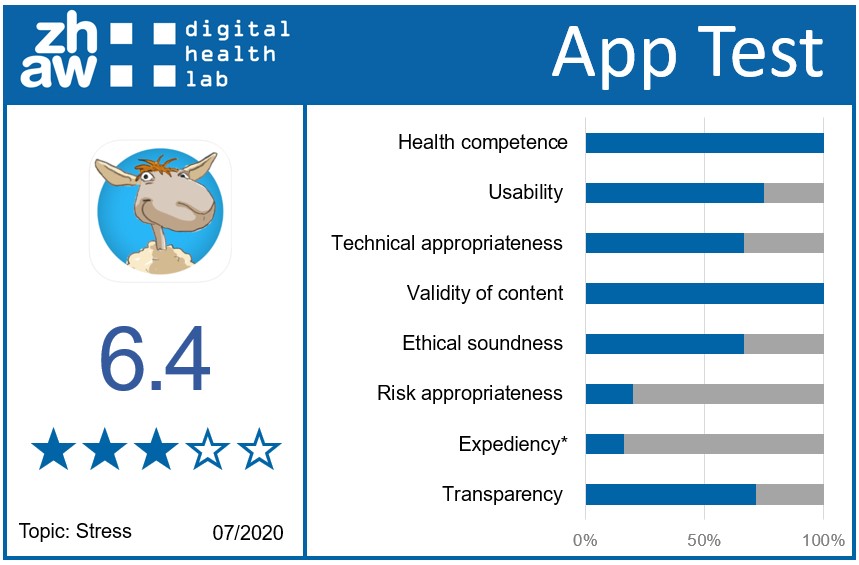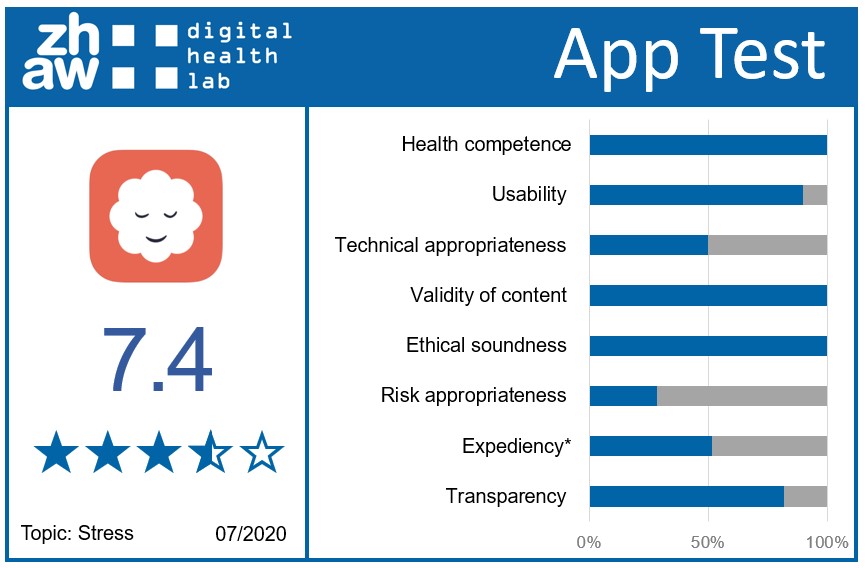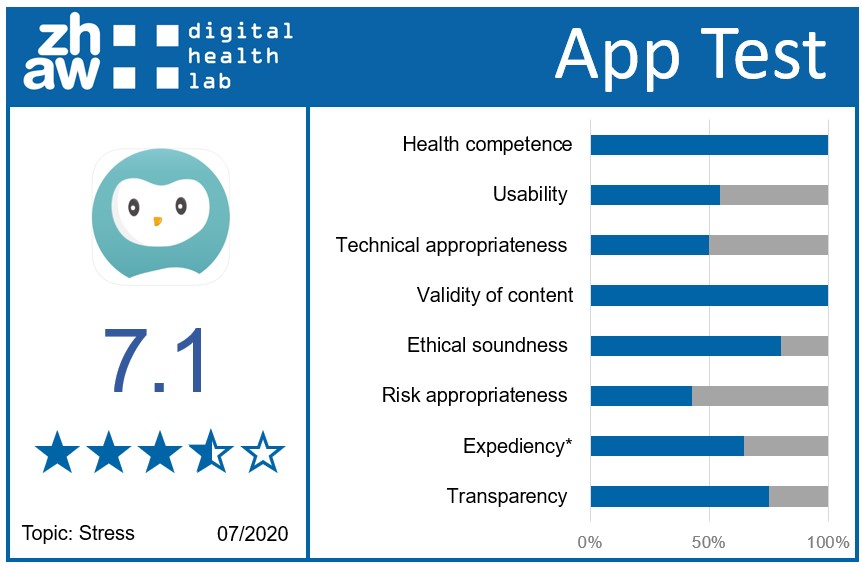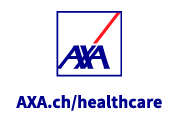Are you looking for reliable health information? Would you like to know more about health apps before you use them? The Health Science research unit of the Zurich University of Applied Sciences (ZHAW) has been commissioned by AXA healthcare to draw up scientifically-based health information and tips on a variety of health topics. It selects and evaluates apps that can provide you with support in these health issues. Please see the Methodology section below for details on how we arrive at these evaluations.
| Information | Tips | Apps |
A modern understanding of stress, triggers, and intensifiers
Stress is a pervasive health problem. How does stress develop and how can it be avoided or managed?
What is stress? – A modern understanding of stress
Stress is a natural reaction to mental or physical stresses. From the standpoint of evolutionary biology, stress is even lifesaving: The secretion of “stress hormones” (such as adrenaline and cortisol) ensures that the body is kept supplied with adequate amounts of energy and oxygen so that it is able to perform at the highest level. This stress reaction is known as the “fight-or-flight response”. Although today’s stress situations no longer involve the flight from a saber-toothed tiger or an enemy tribe, the principle remains the same.
Recurrent acute or prolonged stressful situations can lead to negative effects on health, including exhaustion and illness. This is connected with the various biochemical and neurological mechanisms that take place in moments of stress. Over the long term, such mechanisms are not good, for example, for the cardiovascular system. But mental health can also suffer under sustained stress.
Researchers make a distinction between eustress and distress. Eustress is positively perceived stress that is ultimately beneficial. It is self-chosen, occurs in a positive context, or ends with satisfaction. Examples would be grueling preparations for a major celebration that ultimately brings much joy, or the stress before an important presentation, for which the presenter subsequently receives praise and recognition from colleagues and the boss. Distress on the other hand is perceived negatively by the individual since it leads to fewer, or even no, “reward moments”. Distress is more likely to be associated with negative health consequences including, for example, panic or burnout [1] .
What are stress triggers and stress intensifiers?
In all areas of life we encounter a wide variety of demands that are capable of triggering stress.
On the one hand, there are external stressors, such as exacting performance demands, too much work, social conflicts, time pressure, frequent interruptions, or a combination of these stressful circumstances. You're almost certainly aware, from your professional or private life, of situations in which such stresses exist and affect you.
On the other hand, personal stress intensifiers are also involved. These include factors such as great impatience, a propensity for perfectionism, a strong desire to control, and a tendency towards going it alone or even placing excessive demands on oneself. The concurrence of external stressors and personal intensifiers increases the risk of experiencing distress.
A wide variety of triggering situations and possible intensifiers means that the occasional bout of stress is almost unavoidable. From a health perspective, acute and short-term stress is not usually problematic. However, the accumulation or prolonged periods of stress should be avoided. The targeted use and the strengths of our own resources can help us achieve and maintain a healthy balance.
Tips for dealing with stress
Avoid stress, manage stress, and strengthen your resources
How can I avoid stress?
The best strategy against stress is certainly to stop stress, or distress, from developing in the first place. The following tips should prove helpful:
- Learn more about yourself
-
The basis for the successful avoidance or management of stress is a conscious perception of stressful situations and the identification of external (e.g. time pressure, little room for maneuver) and internal causes (e.g. very high expectations of yourself).
- Recognize your personal signs of stress (e.g. headaches, poor sleep, palpitations, gastrointestinal symptoms)
- Think about situations that you are currently having to face, and draw up an interim balance sheet (e.g. with questions such as: "What were my hopes? My expectations? My assumptions?")
- Manage the demands
-
Foresighted planning and the active use of strategies can help identify, defuse, or even completely avoid potential stressful situations at an early stage.
- Review the goals that are set for you and that you impose on yourself: Are they feasible? If not, how can you adapt these or strengthen your resources? (e.g. seek more support for a work project or give yourself more time to prepare for a major vacation trip)
- Set priorities (e.g. what will take you closer to achieving your important medium-term goals?)
- Learn how to set limits for yourself (e.g. don't feel responsible for everything, or try saying "no" sometimes)
- Estimate the actual time needed realistically (e.g. plan your tasks and consider how long you actually needed in the past, adapt your planning, stay patient)
How can I manage stress?
It is not always possible to avoid negative stress. Not everything is under your control. In such cases, effective management is crucial, particularly if the stress persists. Specific instrumental, mental, and regenerative strategies are available for this purpose.
The latest findings indicate that stress management interventions are effective and offer the potential to substantially reduce stress-related psychological health problems, both in relation to classical [3], and digital stress management interventions [4].
- Break through acute stress situations
-
Stress occupies our thoughts, feelings, and actions. Actively disrupting this stressful tunnel vision helps give us a break from the stresses and develop a fresh perspective.
- Distance yourself from negative feelings (e.g. breathe deeply three times, straighten up and stretch out, close your eyes)
- Focus your attention on something positive (e.g. look out of the window at the countryside, listen to or make music)
- Be constructive and compassionate with yourself (e.g. "I've already overcome a lot, now I'm doing my best, but I'm just one person")
- Let off steam (e.g. practice a sport or relax by going for a walk)
- Train your stress management skills
-
If you would like to improve your ability to manage stress without too much effort, you will need to constantly work on your own everyday thought and behavior patterns.
- Reduce additional external stressors and optimize your problem-solving skills. Clarify your performance requirements for example – or cut your workload by reducing time wasters or avoidable tasks. If this is not possible, counter time pressure by incorporating buffer periods and undisturbed work windows.
- Personality differences can also serve as major stressors. Resolve social conflicts quickly or distance yourself slightly if necessary.
- Reduce personal stress intensifiers by reflecting and working on your attitude. For example, consider whether the result really needs to be achieved so quickly, or whether the results need to be perfect. Eighty percent may also be sufficient. Clarify what is actually expected of you. Also, view the involvement of others and accepting help as a strength, and treat yourself sympathetically when something doesn't succeed.
- Learn relaxation techniques (e.g. autogenic training, progressive muscle relaxation, yoga, meditation) and practice these techniques regularly.
What else can I do?
An average day offers numerous opportunities to actively improve your health . With good habits you will be equipped to cope with stressful situations and challenging times more effectively.
- Strengthen your resources
-
An average day offers numerous opportunities to actively improve your health. With good habits you will be equipped to cope with stressful situations and challenging times more effectively. Behaviors that give you pleasure and that have already proved successful in the past are particularly promising.
- Develop a structure for your day and stick to it (e.g. start the day with a morning ritual and end it with a fixed evening ritual)
- Incorporate specific interruptions and breaks in your day (e.g. think about how you would like to let others know that your exercise breaks are non-negotiable)
- Relax passively (e.g. sunbathe briefly, ensure that you get enough sleep), but also actively in particu-lar (e.g. take up a hobby or regular exercise)
- Create positive experiences (e.g. consciously enjoy a good meal, time with friends, or go to a concert)
- Activate your social skills and give and receive social support (e.g. talk with your contacts, write short messages, make spontaneous calls, arrange video chats, meet others in person, or go on vacation together)
Selected Apps
The Health Science research unit has evaluated a number of apps that can be helpful to you in respect of a particular health topic. The evaluation of an app is based on the following categories.
- Transparency
-
A transparent app gives the potential user sufficient information on the use, objectives, costs, and data usage, along with an adequate site notice so that they can make an individual and collective usage decision.
- Expediency (incl. change in behavior)
-
An expedient app contains functions that are appropriate for the envisaged purpose. The evaluation of the expediency of these apps is based on the use of recognized behavioral change techniques.
- Risk appropriateness
-
A risk-appropriate app can be used without the user or those close to them being exposed to any disproportionate health, social, or economic risk. Aspects evaluated include low-risk default settings and access rights, along with information on reliability of diagnoses or recommendations.
- Ethical soundness
-
An ethically sound app takes into account ethical principles valid in Switzerland as well as standards of good scientific practice. Among other things, the protection of the individual’s private sphere and the separation of advertising and content has been reviewed.
- Validity of content
-
An app is deemed to have valid content if the health-related content used is trustworthy. The evaluation here focused on the separation of objective and subjective content and the transparency of the sources of content.
- Technical appropriateness
-
An app is deemed to be technically appropriate if its development, operation, maintenance, and use corresponds to the latest state of technology and facilitates enduring maintainability and compatibility. Among other things, technical appropriateness was measured on the basis of technical reliability, possible operating systems, and data transfer options. Many aspects of technical appropriateness can only be evaluated and declared by the developer.
- Usability
-
An app is deemed to have good usability if the software is appropriate to the target group in question and contributes to the user’s satisfaction. Aspects evaluated here include functionality, error messages, support options, and off-line usability.
- Health competence
-
An app is deemed to be health-competent if the language, measurement units, and recommendations are clear and comprehensible.
- Resource efficiency
-
An app is deemed to be resource-efficient if, during development, resource-efficient use has been taken into consideration, for example with regard to the use of electricity, storage capacity, or computing power. This category cannot be evaluated without prolonged use or developer information.
- Legal compliance
-
An app is deemed to be legally-compliant if it guarantees compliance with the legal situation, encompassing areas such as medical product law, professional law, or data protection law of the relevant operating countries. This category is not always applicable / cannot always be evaluated, and is only scrutinized in the case of medical product apps.
App Body2Brain

*Only a percentage of the fulfilled criteria is indicated.
Language: German
Body2Brain offers instructions for various simple forms of bodily exercise – e.g. standing up straight – that have a positive effect on your physical and emotional wellbeing. You can adapt the exercises in line with your current mood, environment, and activity.
Detailed app rating Body2Brain
App MyLife Meditation

*Only a percentage of the fulfilled criteria is indicated.
Language: English
MyLife Meditation guides you in regular relaxation through meditation, breathing, and mindfulness exercises. The app offers a check-in function that asks for your current physical and emotional state and then suggests suitable activities (e.g. breathing exercises if you’re stressed).
Detailed app rating MyLife Meditation
- Advantages / Disadvantages
-
Advantages: The MyLife Meditation app offers meditation sessions of different lengths on a variety of themes without the need for a premium subscription. It uses 16 behavior change techniques. For instance, it rewards you with a sticker when you complete an activity.
Disadvantages: The app doesn’t refer you to professional help if your physical and emotional state is poor. The warning that the app isn’t a substitute for medical diagnosis and treatment isn’t placed in a prominent enough position.
App Remente

*Only a percentage of the fulfilled criteria is indicated.
**Criteria not applicable.
Languages: German, English, Spanish, Italian, Swedish
Remente supports you in setting goals and making specific plans, and it reminds you about the goals you’ve set for yourself. Courses teach you about various topics, including ten ways to deal with work stress. You can keep a journal of your thoughts, moods, and life balance, and the app presents you with a personal round-up at the end of each week.
- Advantages / Disadvantages
-
Advantages: Remente offers 19 behavior change techniques to avoid and overcome stress, in particular with regard to goals and planning. The app also records your satisfaction with eight aspects of your life and suggests suitable ready-made goal plans to improve your general level of satisfaction and life balance.
Disadvantages: The app records all activities in the journal. This user tracking can’t be turned off. Remente uses some of your data for customer profiling to improve its offering.
App Wysa

*Only a percentage of the fulfilled criteria is indicated.
Language: English
Wysa helps you to think positively, set goals, learn all about stress, and try breathing, movement, and relaxation exercises. In the app, you chat with a penguin called Wysa. The chatbot was developed using artificial intelligence and trained to listen empathically and ask the right questions. You can also choose to have Wysa give you daily exercise reminders and present all your completed exercises and chats in a journal.
- Advantages / Disadvantages
-
Advantages: Interacting with and being guided by the penguin is a pleasant experience. The app includes 20 behavior change techniques that help you to improve your self-confidence and unlock your inner strengths, among other things. You chat with Wysa anonymously using a nickname, so your privacy is protected. You can protect your data on your device with a password.
Disadvantages: Chatting with Wysa works well on the whole, but Wysa doesn’t always understand everything. You can’t use the app offline, and you have to uninstall the app and reset your settings to delete all your user data.
The content on the subject of stress was scientifically compiled by the ZHAW. The commission for this and the financing was provided by AXA.
Methodology – evaluation and selection
- How did we arrive at the app criteria?
-
Where the catalog of criteria for the evaluation of apps is concerned, we have focused on three key resources.
- “Einheitlichen Kriterienkatalog zur Selbstdeklaration der Qualität von Gesundheits-Apps” (Standardized catalog of criteria for self-declaration of quality of healthcare apps)
This catalog by ehealthsuisse, the relevant center of competence and coordination for the Confederation and cantons in Switzerland, formulates nine categories for quality review, of which we have used seven for the purposes of our evaluation criteria. The two criteria not taken into account were “resource efficiency” and “legal compliance”, as these are only partially applicable or reviewable. The category “health competence” was newly created by the Health Science research unit.
- “APPKRI-Kriterien für Gesundheits-Apps” [APPKRI criteria for health apps”], drawn up by the Fraunhofer Institute for Open Communication Systems
These app evaluation criteria have been developed on behalf of the Federal Ministry of Health in Germany. This meta-criteria catalog currently encompasses 290 criteria and forms the basis for our evaluation criteria. The ZHAW research team has identified 56 criteria as key to the app evaluation process.
- “The behavior change technique taxonomy” by Susan Michie and colleagues [5]
One focus of our app evaluation is the techniques of behavior change. When evaluating the “Expediency” category, the 93 behavior techniques of this taxonomy were reviewed for their use in the app. For example, the display of duration of relaxation exercises by an app constitutes a form of “behavior feedback” and therefore a recognized behavior change technique.
- How have we evaluated the app criteria?
-
- The criteria have been evaluated with yes (applies) or no (does not apply) and irrelevant. The evaluations of the individual criteria for each app are available in PDF form.
- The bar charts correspond to the percentage proportions of the criteria per category that were evaluated with a “yes” or “no”. Only applicable criteria are used in the calculation.
- The stars correspond to the aggregated total of the criteria answered with “yes” across all categories, e.g. four stars means that 80% of the evaluated criteria were answered with “yes”.
- How did we arrive at our app selection?
-
We identified apps through the program 250 using topic-specific search terms. On the basis of various features we then made a pre-selection from the large pool of apps identified. The apps that you can find on the website also reflect the multiplicity of methods and approaches common in the healthcare area.
Selected apps had to…
- be offered both for the iOS and Android operating systems,
- exhibit a full site notice,
- only request access to the personal data needed for use of the app,
- require no additional hardware.
- offer privacy protection settings,
- be usable without a permanent internet connection,
- list both the function and price of in-app purchases,
- specify the scope and duration of usage rights,
- stipulate the usage scenarios for which the app is not suitable,
- not impair usage significantly through pop-up advertising or similar,
- function flawlessly and reliably,
- not offer any incentives to pass on personal or third-party data,
- lag up any incorrect use as risky,
- clearly define the goal achievable through use of the app in the App Store,
- and use language that would be readily comprehensible to the target group.
- References
-
- Habermann-Horstmeier, L. (2017). Risikofaktor "Stress". Kompakte Einführung und Prüfungsvorbereitung für alle interdisziplinären Studienfächer. Band 3 von Kompaktreihe Gesundheitswissenschaften. Bern: Hogrefe.
- Kaluza, G. (2011). Stressbewältigung. Berlin: Springer.
- Richardson, K. M., & Rothstein, H. R. (2008). Effects of occupational stress management intervention programs: A meta-analysis. Journal of Occupational Health Psychology, 13(1), 69–93. https://doi.org/10.1037/1076-8998.13.1.69
- Heber, E., Ebert, D. D., Lehr, D., Cuijpers, P., Berking, M., Nobis, S., & Riper, H. (2017). The benefit of web- and computer-based interventions for stress: A systematic review and meta-analysis. Journal of Medical Internet Research, 19(2), e32. https://doi.org/10.2196/jmir.5774
- Michie, Susan, Michelle Richardson, Marie Johnston, Charles Abraham, Jill Francis, Wendy Hardeman, Martin P. Eccles, James Cane, und Caroline E. Wood. „The Behavior Change Technique Taxonomy (v1) of 93 Hierarchically Clustered Techniques: Building an International Consensus for the Reporting of Behavior Change Interventions“. Annals of Behavioral Medicine 46, Nr. 1 (August 2013): 81–95. https://doi.org/10.1007/s12160-013-9486-6

